Analyzing Intel Core M Performance: How 5Y10 can beat 5Y71 & the OEMs' Dilemma
by Brett Howse & Ian Cutress on April 8, 2015 8:00 AM EST3DMark Sky Diver Results
Most of the previous benchmarks were day to day tasks. Some involved the GPU, but it was never the focus. We will now move on to benchmarks which focus on GPU performance to see what kind of an effect this can have. Remember, the TDP of Core M is 4.5 watts including the integrated graphics, so any thermal room needed for graphics is going to come at the expense of the CPU. 3DMark Sky Diver is aimed for gaming laptops and mid-range PCs, so it is a bit too much load for integrated graphics. But it does feature DirectX 11 and includes both graphics and physics tests. The benchmark is around five minutes long.
We can see that the Core i5 continues shrugging off these tests. While the SoC did heat up, the GPU frequency was flat throughout the results. This is quite a bit different than all of the Core M processors, which had to throttle both the CPU and GPU as needed. It is very interesting especially in the UX305 results to see that the GPU is throttled on high CPU workloads to give more headroom for the CPU, which you can see on the third heat spike in its graph. This would be the physics test, which relies heavily on the CPU. The Dell Venue 11 and Yoga 3 Pro had very different temperature curves, and the Yoga 3 Pro had to throttle the GPU quite a bit to stay at its target SoC temperature.
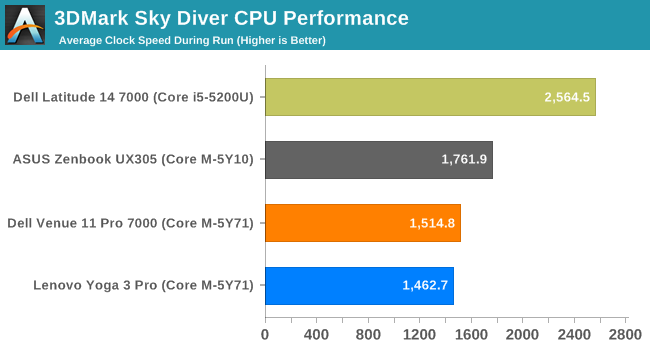
Looking at the average CPU frequencies reaffirms what we have seen in previous results. The ASUS, despite having the lowest turbo frequency, has the highest average for the Core M devices. But it is the GPU frequencies which are the most important in this test.
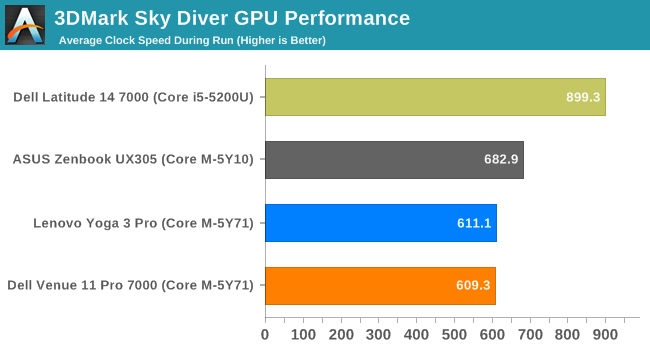
All of the Core M devices had to throttle the GPU to some extent, but the ASUS did the least. The Yoga 3 Pro and Dell Venue 11 Pro were basically tied in average GPU frequency for the duration of this test. GPU workloads can pull a lot of power into the SoC, which can raise temperatures as we will see in the next graph.
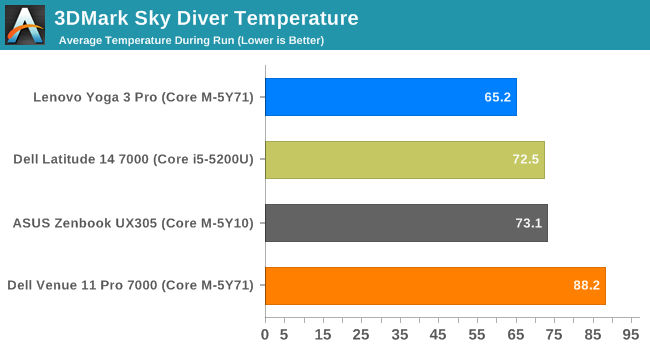
Looking at the SoC temperatures explains the results. The Yoga 3 Pro has an average of 65.2°C, which is the target temperature for the Yoga. This means it was not able to leverage the breaks in workloads to ramp up its higher turbo frequencies when needed. The Dell Venue 11 is at almost 90°C for the benchmark, and that is also its limit. The ASUS, with its better cooling, manages to basically mirror the Core i5 for SoC temperature.
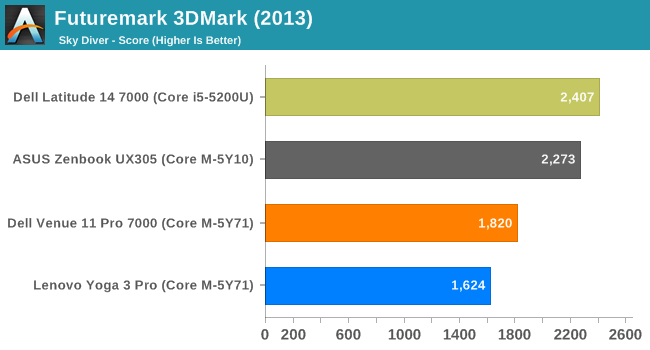
The excellent cooling of the ASUS form factor shines in the GPU tests. For the overall score, it comes very close to the Core i5. Both of the 5Y71 devices struggle under sustained GPU workloads, as the scores confirm.


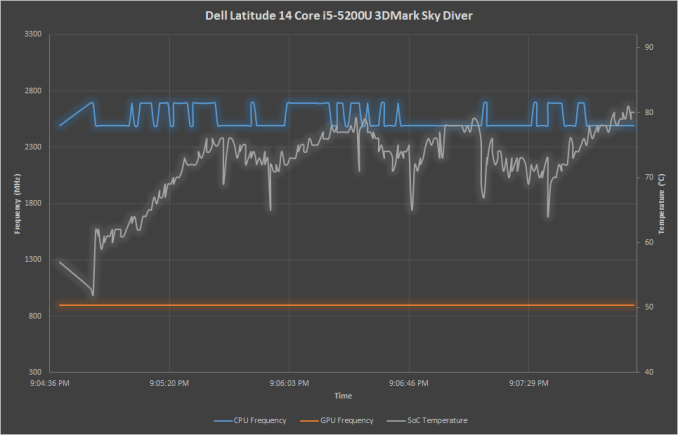
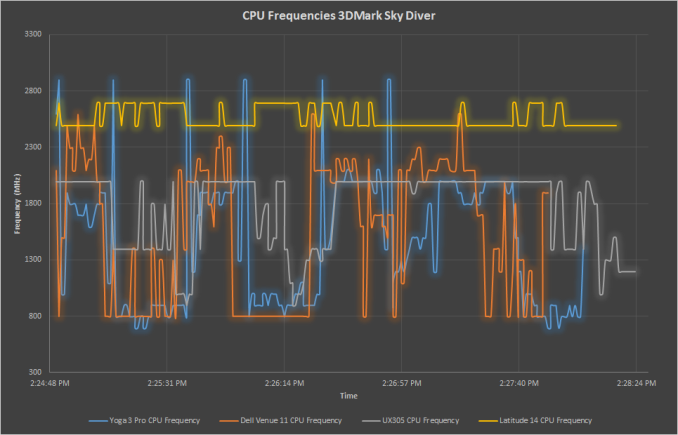
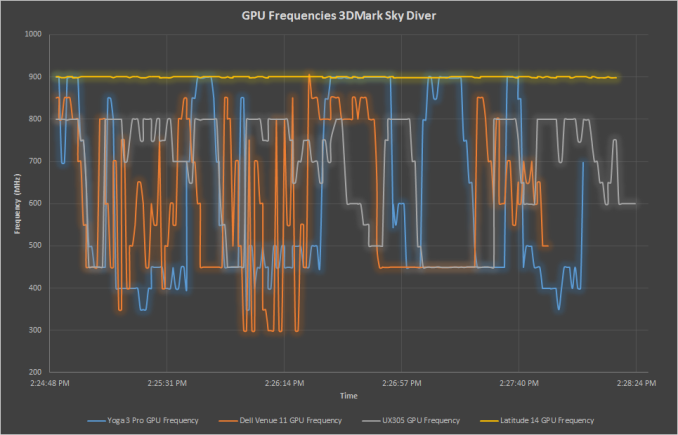
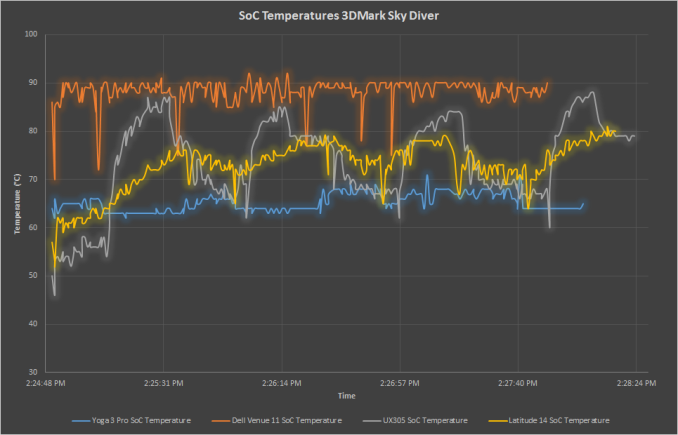








110 Comments
View All Comments
zodiacfml - Wednesday, April 8, 2015 - link
A long for this look at the performance Core M. Thanks. Like all nice, popular movies the end is pretty expected after a review from the Asus UX305. It's also good that the Dell is there to provide the scores for no limitation on cooling for long continuous loads.After all this, I don't see any problem. The performance of the Asus is pretty expected as well having a tradional notebook design which is fairly overkill for the SDP/TDP.
I was a PC overclocker many years ago and then realized that underclocking and overclocking at the same time would be ideal. I believe the race to wider CPU dynamic range has become mainstream.
dragonsqrrl - Wednesday, April 8, 2015 - link
"Each model comes with 4MB of L2 cache" On the first page.Shouldn't that be L3 cache?
dananski - Wednesday, April 8, 2015 - link
I love how the Asus tries to draw a piano keyboard in the PCMark 8 Creative graph. Very creative of it.DryAir - Wednesday, April 8, 2015 - link
The temperature x time graphs are all messed up. The lines goes "back" on many ocasions, indicating 2 different temperatures on a same time stamp. You should check the settings on whatever program you are using to generate these graphics.be_prime - Wednesday, April 8, 2015 - link
I just signed up to comment on the same thing -- the graphs are so clearly distorted by some (no doubt well-intentioned) spline/smoothing that much (even most?) of the data we see here may be the product of a spline or interpolation process, and not represent a data measurement. Where the line goes "back", as DryAir pointed out, it implies time travel.That's a very big miss for a site that I've considered to be thoughtful and authoritative. The approach you took here presents false and interpolated data and obscures the quality of your research. Don't let the goal of an attractive graph ruin the whole point of the graph: showing the data.
These graphs are obviously impossible due to the spline/interpolation used, and should be replaced by a scatter plot or normal line graph.
Brett Howse - Wednesday, April 8, 2015 - link
As I mentioned on the Devices and Test page, sometimes the devices were very heavily loaded and they were not able to log consistently. Sometimes they would log twice in the same second, but with slightly different values. One log would be time 0:00:01:05, and another would log 0:00:01:95 (for instance), but both would be truncated to the same second. Unfortunately that's just the limit of the software, since it only logs time to the nearest second. A second can be a lot of time for a CPU.be_prime - Thursday, April 9, 2015 - link
That's fine because those data points represent measurements.The problem here is you've used interpolated splines/curves which, in this case, actually show impossible or false information: the curve leaning "left" implies that the x-axis (time) is decreasing: that's time travel, and it'd be a bigger story than the Core M for sure, right?
Also recognize that if you're gathering data points, but drawing a line, you're always implicitly creating an interpolation between those points (at least in viewers minds). Usually, it doesn't matter so much. Here, the resulting lines are false, and I think Anandtech is a better publication than that.
As it stands, the interpolation/smoothing on your graphs implies time travel. Respectfully: please correct this (or, patent the relevant technology and profit!). If you're going to make your graphs look "pretty" and don't care if they're correct, I can't trust your results.
DryAir - Friday, April 10, 2015 - link
Sarcastic time travel jokes aside, I agree that you should change it somehow. Perhaps just change the data points to be connected to a straith line, instead of a smoothed one. Right now its looking very amateuristic, not matching an otherwise great and highly technical review.Brett Howse - Friday, April 10, 2015 - link
Ice Storm was the worst offender so I've re-generated the graphs with straight lines. There just was not enough data points on that one because it was so short.gw74 - Wednesday, April 8, 2015 - link
I am furious that OEMs are using Core M in ultrabooks. It is the solution to a problem which does not exist. The Samsung Series 9 / ATIV 9 Plus use full fat i5 and i7 ULVs and the 2 tiny fans hardly ever come on. when they do, they sound like mice whispering. and huge battery life.Core M is not progress when used in the ultrabook factor. it is a step backwards and a ripoff.